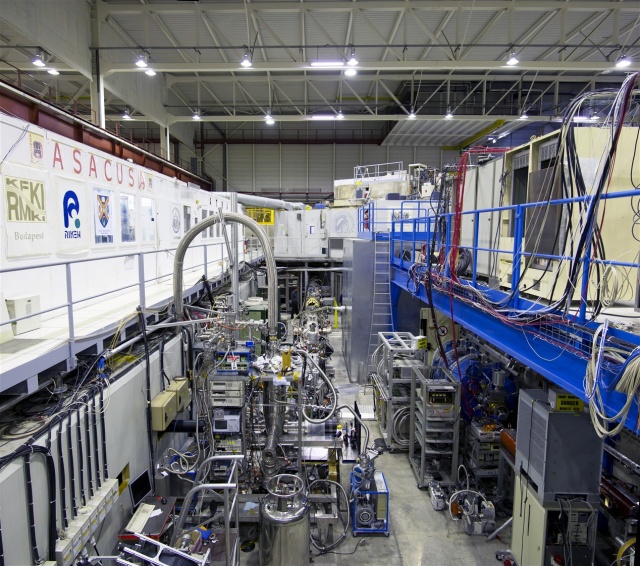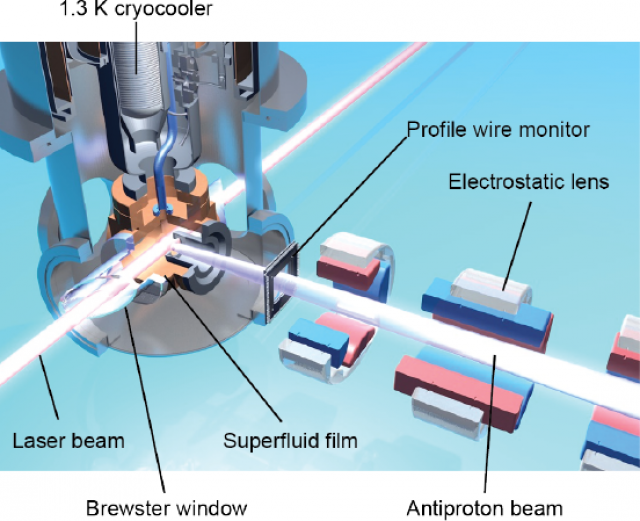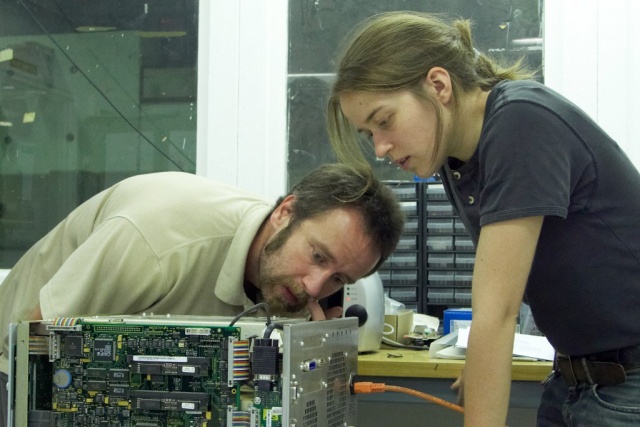Antimatter factory at CERN: a breakthrough with a Hungarian contribution
A new, innovative cooling technique was used to increase the measurement precision of the antiproton mass at CERN. Within the framework of the ASACUSA cooperation, physicists defined the mass of the antiproton relative to that of the electron. The results of the experiment conducted with the contribution of Hungarian researchers have been published in Science.
10 November, 2016
One of the greatest mysteries of modern physics is the lack of antimatter in the universe as the Big Bang must have created the same amount of matter and antimatter. CERN has built an antimatter factory to investigate the question of whether any difference between particles and antiparticles would be able to explain this strange asymmetry.
 The ASACUSA experiment at CERN’s antimatter factory. The pipe above the measurement equipment leads to the huge cooling equipment behind the concrete wall. Source: MTA Wigner Research Centre for Physics
The ASACUSA experiment at CERN’s antimatter factory. The pipe above the measurement equipment leads to the huge cooling equipment behind the concrete wall. Source: MTA Wigner Research Centre for PhysicsThe ASACUSE collaboration, involving mainly Japanese, Hungarian, Austrian and Italian participants, is one of several experiments going on in the antimatter factory and has made a major breakthrough in defining the mass of the antiproton relative to that of the electron through the application of a new, innovative cooling technique. On 4 November, the prestigious scientific journal Science reported the researchers’ findings about the ASACUSA experiment on the novel, highly-improved precision measurement of antiproton mass compared to electron mass. The twelve authors of the article include six scientists from Japan, three from Hungary (Anna Sótér, Dániel Barna and Dezső Horváth), and one each from Italy, Germany and Iran.
 The experiment apparatus. The laser beam is shone from the left, the electrostatically focused antiproton beam enters from the right, and cooling is done from above, creating a superfluid helium layer on the walls of the high-grade copper container. Source: MTA Wigner Research Centre for Physics
The experiment apparatus. The laser beam is shone from the left, the electrostatically focused antiproton beam enters from the right, and cooling is done from above, creating a superfluid helium layer on the walls of the high-grade copper container. Source: MTA Wigner Research Centre for PhysicsIn the experiment antiprotons were trapped in helium atoms, thus replacing one of the electrons. The scientists managed to cool down nearly 2 billion long-lived antiprotonic helium atoms to absolute temperatures of 1.5-1.7 K and to effectively eliminate thermal movement in order to greatly improve the precision of the laser spectroscopic measurements. The antiprotonic helium atom is of an especially unique quality: the helium nucleus binds an electron and an antiproton, so it contains a particle and an antiparticle at the same time, creating such a physical state and resulting in a life span long enough to allow for the spectroscopic measurements of its atomic transitions.
The novel achievement of the collaboration is that it managed to surround the studied antiprotonic atoms with extremely cold helium gas. In the antiprotonic helium atom, the electron is in an orbit of much greater radius than the antiproton, therefore, in collisions with cold gas atoms, it is capable of cooling down without the antiproton being captured in the nucleus and radiating away. The latter occurs only if the antiproton is successfully degenerated as resonance by the use of an appropriately tuned laser. This is how transition energy is measured, from which mass can be defined with high precision. The experiment, with data collected between 2010 and 2014, confirmed the symmetry between matter and antimatter, as the mass of the antiproton and that of the proton turned out to be identical to more than ten digits of precision.
 Two Hungarian contributors to the ASACUSA experiment, Dániel Barna and Anna Sótér Source: MTA Wigner Research Centre for Physics
Two Hungarian contributors to the ASACUSA experiment, Dániel Barna and Anna Sótér Source: MTA Wigner Research Centre for Physics The next phase of the experiment will be to further reduce spectroscopic uncertainty due to the movement of atoms with the use of two laser beams shone from opposite directions, which eliminates the effect of longitudinal movement. In this process, the antiproton storage ring, ELENA, currently under construction in the antimatter factory, is expected to play an important role.
The article, published in Science, can be found here: http://science.sciencemag.org/content/354/6312/610
